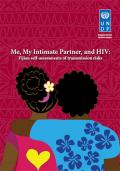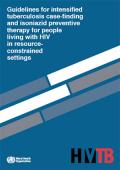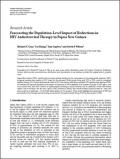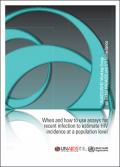What's New
Displaying results 3721 - 3730 of 4914

Resource | Publications,
This article aims to investigate the processes, actors and other influencing factors behind the development and the national scale-up of the One Stop Crisis Centre (OSCC) policy and the subsequent health model for violence-response. Methods used included policy analysis of legal, policy and regulatory framework documents, and indepth interviews with key informants from governmental and non-governmental organisations in two States of Malaysia. The findings show that women’s NGOs and health professionals were instrumental in the formulation and scaling-up of the OSCC policy.

Resource | Publications,
This report is designed to strengthen Fiji’s response to HIV and AIDS. The aim of our study was to provide useful data about how Fijians think of and manage their risks of sexual transmission of HIV. We used multiple research methods and instruments to investigate the cultural, cognitive, and behavioral factors that shape HIV and STI transmission risks in Fiji. For the sake of brevity, we did not include here research protocols and instruments, letters of introduction and research clearance, statements of informed consent, and the like, but they can be obtained upon request to UNDP.
Fijians currently face a terrible dilemma without benefit of critical, open discussion of the individual and public health consequences of sexual ethics. Fijians can avoid infections by having sex that is better protected (by condoms), and perhaps even with a larger number of persons, with consent, communication, and mutuality of pleasure, or they can adhere to cultural and religious rules to have sex only with a legal spouse of the opposite sex but without condoms.

Resource | Publications,
Gender inequality impacts health in myriad ways, including "discriminatory feeding patterns, lack of
decision-making power, and unfair divisions of work, leisure, and possibilities of improving one's
life, in addition to limited access to health care services. One of the most significant consequences of gender inequality, however, is gender-based violence (GBV), including sexual violence, coercion, emotional and/or physical violence perpetrated by intimate partners and non-partners alike. GBV "reflects and reinforces inequality between men and women…[compromising] the health, dignity, security and autonomy" of its survivors.
This draft background paper is one of several in a series commissioned by the World Health Organization for the World Conference on Social Determinants of Health, held 19-21 October 2011, in Rio de Janeiro, Brazil. The goal of these papers is to highlight country experiences on implementing action on social determinants of health.

Resource | Publications,
Despite the grave consequences of sexual violence, and it’s persistence both within and outside marriages, this subject has received relatively little attention from researchers, policy makers, and programme managers in Nepal. This paper explores the definition of sexual violence and its various forms and consequences as reported by young married women in Nepal. In addition, it describes the coping mechanisms used by young married women to avoid sexual violence perpetrated against them by their husbands.

Resource | Guidelines,
HIV is the strongest risk factor for developing tuberculosis (TB) disease in those with latent or new Mycobacterium tuberculosis infection. The risk of developing TB is between 20 and 37 times greater in people living with HIV than among those who do not have HIV infection. TB is responsible for more than a quarter of deaths in people living with HIV.
On 25–27 January 2010, WHO conducted a global policy meeting to review the evidence regarding ICF and IPT, and to reconceptualize the 1998 WHO/Joint United Nations Programme on HIV/AIDS (UNAIDS) Policy on TB prevention. Key questions were identified and a comprehensive review of the available scientific evidence was conducted to formulate the recommendations.
The final recommendations take into consideration the quality of evidence, cost, feasibility, and values and preferences of the community and health-care workers.

Resource | Publications,
Tuberculosis (TB) and HIV/AIDS are the two major public health problems in the South Asian Association for Regional Cooperation (SAARC) region. In the field of TB control DOTS strategy has made a remarkable progress, however, emerging HIV epidemic has posed a major challenge to TB control efforts.
This is a revised edition of "SAARC Regional Strategy on TB/HIV Co-infection" which presents an outline of regional strategy focused on areas of collaboration and directed towards the development and implementation of successful programmes for control of TB/HIV co-infection. This document highlights the SAARC regional context and points out major TB, HIV/AIDS and TB/HIV co-infection status and concerns, outlines strategy goal, objectives and expected outcomes. This document also explains the Strategy on the basis of its five different components.

Resource | Publications,
In June 2010, the UNAIDS Secretariat and WHO launched Treatment 2.0, an initiative designed to achieve and sustain universal access and maximize the preventive benefits of antiretroviral therapy (ART). Treatment 2.0 builds on '3 by 5' and the programmatic and clinical evidence and experience over the last 10 years to expand access to HIV diagnosis, treatment and care through a series of innovations in five priority work areas: drugs, diagnostics, costs, service delivery and community mobilization. The principles and priorities of Treatment 2.0 address the need for innovation and efficiency gains in HIV programmes, in greater effectiveness, intervention coverage and impact in terms of both HIV-specific and broader health outcomes.
Since the launch of Treatment 2.0, the UNAIDS Secretariat and WHO have worked with other UNAIDS co-sponsoring organizations, technical experts and global partners to further elaborate and begin implementing Treatment 2.0.

Resource | Presentations,
HIV Testing & Treatment as Prevention in China
National Center for AIDS/STD Control and Prevention
Chinese Center for Disease Control and Prevention

Resource | Publications,
Papua New Guinea (PNG) is a low income country that has experienced a rapidly expanding HIV epidemic. It has the highest HIV prevalence and incidence rate in the Pacific region with 28,294 HIV infections reported by December 2008 since the first diagnosed case in 1987. The vast majority of HIV cases have been due to heterosexual transmission with similar numbers of diagnoses in men and women. Fortunately, recent estimates suggest there has been a leveling out of HIV prevalence in PNG at approximately 1%. The reasons for this leveling of prevalence are currently unknown but could be due to the saturation of HIV in particular at risk population groups or geographic areas, or reflect the impact of the roll-out of intervention programs in recent years and the successful scale-up of antiretroviral therapy (ART) services across the country. ART first became available in PNG in 2004 and the PNG National Department of Health recently estimated that more than 70% of people requiring treatment were receiving it in 2009.

Resource | Publications,
It is more than a decade since the first report appeared of a laboratory test aimed at distinguishing recently acquired HIV infections from infections of a longer duration. Several expert groups have now developed tests of this kind, based on the underlying principle that the immunological response to HIV infection evolves for a number of months following infection, and that it is possible to identify a marker for the early period. This marker eventually disappears and can therefore serve as an indicator of recent infection. For the purpose of these tests, “recent” generally means a period of up to a year after infection has been acquired.
The document reviews the public health importance of estimating the HIV incidence in populations, and the various methods that have been used for this purpose. It provides guidance on the way in which laboratory tests for recent HIV infection may be used to estimate HIV incidence in populations, particularly with regard to sampling designs, sample size and the statistical analyses that should be employed.





